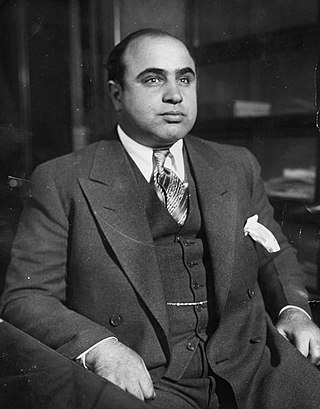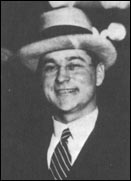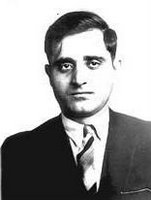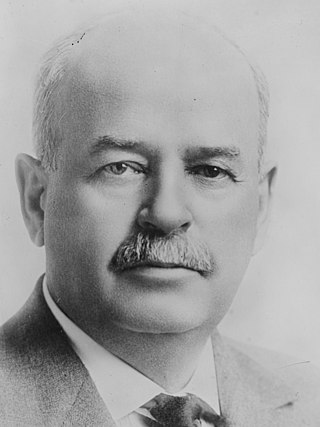This article needs additional citations for verification .(March 2010) |
George "Babe" Tuffanelli (born Constant Tuffanelli [1] ) (1903-1975) was an Italian-American mobster who ran Chicago's South Side for Al Capone.
This article needs additional citations for verification .(March 2010) |
George "Babe" Tuffanelli (born Constant Tuffanelli [1] ) (1903-1975) was an Italian-American mobster who ran Chicago's South Side for Al Capone.
Tuffanelli was born in Italy and came to America with his brother Luigi Tuffanelli around 1900. Luigi got sick on the voyage; therefore, he was not permitted to enter the U.S. So both brothers jumped ship and came into America as illegal immigrants, settling in New York City.
Tuffanelli got more involved in the life of crime and became more invested in the Italian Mafia as time passed. He moved to the southside of Chicago, where he became a friend and associate of notorious gangsters such as Al Capone and Jimmy Derrico. Tuffanelli became a powerful member in the Chicago Outfit and ran the southside as boss of Blue Island. [2] [3]
After his rise to power and success, he started investing his money in racecars [4] and then moved with the mob to Las Vegas, Nevada, to invest in the casinos.

Alphonse Gabriel Capone, sometimes known by the nickname "Scarface", was an American gangster and businessman who attained notoriety during the Prohibition era as the co-founder and boss of the Chicago Outfit from 1925 to 1931. His seven-year reign as a crime boss ended when he went to prison at the age of 33.

Joseph John Aiuppa, also known as "Joey O'Brien" and "Joey Doves", was a Chicago mobster who became a leader of the Chicago Outfit from 1971 until his skimming conviction in 1986.

John Donato Torrio was an Italian-born American mobster who helped build the Chicago Outfit in the 1920s later inherited by his protégé Al Capone. Torrio proposed a National Crime Syndicate in the 1930s and later became an adviser to Lucky Luciano and his Luciano crime family.

Frank Ralph Nitto, known as Frank Nitti, was an Italian-American organized crime figure based in Chicago. Bodyguard of Al Capone, Nitti was in charge of all money flowing through the operation. Nitti later succeeded Capone as acting boss of the Chicago Outfit.

Vincenzo Colosimo, known as James "Big Jim" Colosimo or as "Diamond Jim", was an Italian-American Mafia crime boss who emigrated from Calabria, Italy, in 1895 and built a criminal empire in Chicago based on prostitution, gambling and racketeering. He gained power through petty crime and heading a chain of brothels. From 1902 until his death in 1920, he led a gang known after his death as the Chicago Outfit. Colosimo was assassinated on May 11, 1920, and no one was ever charged with his murder. Johnny Torrio, an enforcer whom Colosimo imported in 1909 from New York, seized control of Colosimo's businesses after his death. Al Capone, a close associate of Torrio, has been accused of involvement in Colosimo's murder but was not yet in Chicago at the time.

Anthony Joseph Accardo, also known as "Joe Batters" and "Big Tuna", was an American longtime mobster. In a criminal career that spanned eight decades, he rose from small-time hoodlum to the position of day-to-day boss of the Chicago Outfit in 1947, to ultimately becoming the power behind the throne in the Outfit by 1972. Accardo moved the Outfit into new operations and territories, significantly increasing its power and wealth during his tenure as boss.

Louis "Two Gun" Alterie, born Leland A. Varain, and aka "Diamond Jack Alterie", was a Californian who became a notorious hitman for the Chicago North Side Gang during the early years of Prohibition.

Paul De Lucia, known as Paul Ricca, was an Italian-American mobster who served as the nominal or de facto leader of the Chicago Outfit for 40 years. In 1958 he was named "the country's most important criminal" by a Senate crime investigating subcommittee. Ricca died on October 11, 1972.

The Chicago Outfit is an Italian-American Mafia crime family based in Chicago, Illinois, which originated in the city's South Side in 1910. The organization is part of the larger Italian-American Mafia.

Lennington "Len" Small was an American politician who served as the 26th Governor of Illinois from 1921 to 1929. He previously was a member of the Illinois state senate from the 16th District from 1901 to 1903 and was Illinois state treasurer, from 1905 to 1907, and from 1917 to 1919. He is known for accusations of embezzlement brought against him.
Chicago, Illinois, has a long history of organized crime and was famously home to the American mafia figure Al Capone. This article contains a list of major events related to organized crime.
The Genna crime family, was a crime family that operated in Prohibition-era Chicago. From 1921 to 1925, the family was headed by the six Genna brothers, known as the Terrible Gennas. The brothers were Sicilians from the town of Marsala and operated from Chicago's Little Italy and maintained control over the Unione Siciliana. They were allies with fellow Italian gang the Chicago Outfit. After a bloody war led to their demise in the 1920s, the gang was eventually absorbed by the Chicago Outfit.

Louis "Little New York" Campagna was an American gangster and mobster and a high-ranking member of the Chicago Outfit for over three decades.
Salvatore "Frank" Capone was an Italian-American mobster who participated in the attempted takeover of Cicero, Illinois by the Chicago Outfit. He worked in the businesses with his brothers Al Capone and Ralph Capone.
Ralph James Capone was an Italian-American mobster and an older brother of Al Capone and Frank Capone. He got the nickname "Bottles" not from involvement in the Capone bootlegging empire, but from his running the legitimate non-alcoholic beverage and bottling operations in Chicago. Further family lore suggests that the nickname was specifically tied to his lobbying the Illinois legislature to put into law that milk bottling companies had to stamp the date that the milk was bottled on the bottle. He was most famous for being named by the Chicago Crime Commission "Public Enemy Number Three" when his brother Al was "Public Enemy Number One".
Claude "Screwy" Maddox, born John Edward Moore, was a Chicago mobster and head of the Circus Cafe Gang whose ranks included future Chicago mobsters Anthony "Tough Tony" Capezio, Vincenzo De Mora and Antonino "Tony" "Joe Batters" Accardo.
Jake "Greasy Thumb" Guzik was the financial and legal advisor, and later political "greaser," for the Chicago Outfit.
The Sheldon Gang was a Chicago criminal gang during the early years of Prohibition known for being the main rivals of the Saltis-McErlane Gang and the Southside O'Donnell Brothers. The gang's primary activities included bootlegging and hijacking of trucks and alcohol shipments.
Rocco Fischetti, also known as "Rocky" and "Ralph Fisher", was a Chicago mobster with the Chicago Outfit criminal organization who ran many illegal gambling operations. Fischetti also accompanied singer Frank Sinatra on two trips to Havana, Cuba.

The 1924 Cicero, Illinois, municipal elections were elections held in 1924 to select municipal officers in Cicero, Illinois. The elections were notable for the gang-related violence which took place.